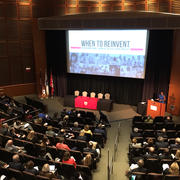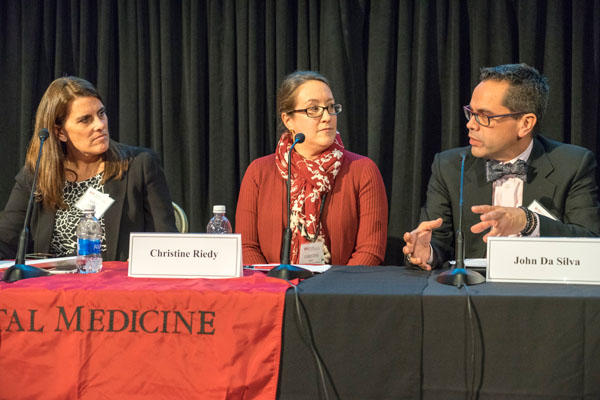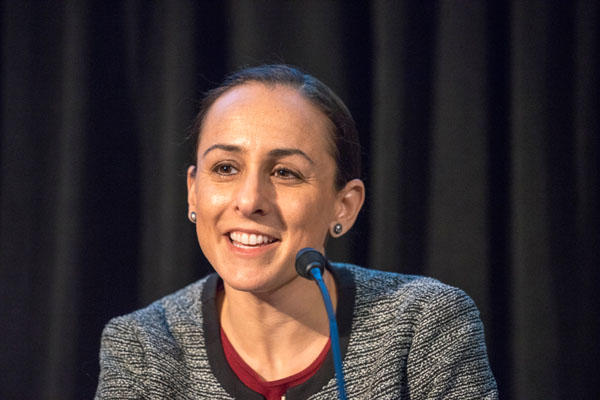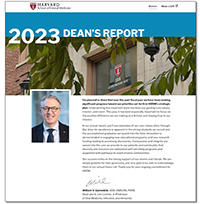
Leaders in academia, healthcare, and business recently came to together at forum hosted by Harvard School of Dental Medicine (HSDM) to address the idea of integrating dentistry and medicine. The two-day event, “Putting Your Money Where Your Mouth Is 2.0,” featured thought-provoking speakers, panelists, and discussion around the idea of connecting oral health to overall health to achieve better patient outcomes and lower costs. The forum looked at integration from all angles—its affect on health in the workplace, in a clinical setting, and as a public policy issue.
Healthier Employees
 Keynote speaker, Marleece Barber, chief medical officer of Lockheed Martin kicked off the forum by providing an employer perspective on the issue. In her role as CMO, Barber is responsible for providing over 113,000 employees around the globe with competitive and affordable health benefits.
Keynote speaker, Marleece Barber, chief medical officer of Lockheed Martin kicked off the forum by providing an employer perspective on the issue. In her role as CMO, Barber is responsible for providing over 113,000 employees around the globe with competitive and affordable health benefits.
“There is a correlation between employee health and wellbeing, and performance,” she said. “However, there is a real gap between what employees and patients are hearing and what’s going on in their mouth.”
Barber added that employers need to better understand the connection between periodontal disease and Type 2 diabetes, as well as heart disease and other health issues, and the impact of these diseases on healthcare costs, employee productivity, and engagement. She suggested that large employers should include dental health in their overall health strategy and employee communications.
David Holmberg, president and CEO of Highmark Health; Tameeka Smith, president of dental and vision at Aetna Health Insurance; and other insurance providers offered perspectives from an insurer’s point-of-view. Holmberg emphasized that an integrated delivery and financing system can lead to improved overall health.
Smith cited a 2015 survey of 15,000 adults that revealed sixty percent experienced dental pain, and fifteen percent needed to take days off from work due to dental-related problems. She said that even those with dental insurance don’t always use it because insurance systems can be difficult to navigate, and could be more user-friendly, transparent and digital.
“We need to do a better job to make sure people understand the benefits they have,” Smith said. “If you can order a car off the street with your phone, you should should be able to find a dentist as easily,” she added.
Modern Models
 Faculty from HSDM, Harvard Medical School (HMS), and Harvard T.H. Chan School of Public Health (HSPH) presented academic studies and projects that have explored integrated medical-dental models. Grant projects such as the HSDM and Northeastern University School of Nursing Nurse Practitioner–Dentist Model bring primary care and dentistry together in the dental clinic. Other proposed models take the idea a step further to envision an entirely “Integrated Practice of the Future,” as outlined by HMS professor of medicine and director of the Primary Care Center, Russell S. Phillips.
Faculty from HSDM, Harvard Medical School (HMS), and Harvard T.H. Chan School of Public Health (HSPH) presented academic studies and projects that have explored integrated medical-dental models. Grant projects such as the HSDM and Northeastern University School of Nursing Nurse Practitioner–Dentist Model bring primary care and dentistry together in the dental clinic. Other proposed models take the idea a step further to envision an entirely “Integrated Practice of the Future,” as outlined by HMS professor of medicine and director of the Primary Care Center, Russell S. Phillips.
Rick Siegrist, director of Innovation and Entrepreneurship at HSPH, moderated a panel on integrating the health record. The panel touched on ways traditional silos can be broken down. “All of us agree integrating medical and dental care is a clinical imperative,” Siegrist said.
In another panel moderated by Leemore Dafny, professor of business administration at Harvard Business School, corporate decision makers including CEOs and CMOs discussed building a financial case for integrated health and medical benefits. Panelists acknowledged that more can be done to look at medical data alongside dental to help inform decision making.
 Additionally, policy experts and economists presented data and financial models that could make the case for integration. Andrew Loewer from Avalere Consulting cited a recent Avalere study that looked at the potential impact of adding a periodontal benefit to traditional Medicare coverage, and found it could lead to a $63.5 billion net estimated savings over ten years.
Additionally, policy experts and economists presented data and financial models that could make the case for integration. Andrew Loewer from Avalere Consulting cited a recent Avalere study that looked at the potential impact of adding a periodontal benefit to traditional Medicare coverage, and found it could lead to a $63.5 billion net estimated savings over ten years.
Underscoring the need for dental benefits to be included in federal programs such as Medicare and Medicaid, Carol Raphael former chair of the American Association of Retired Persons (AARP) and former CEO of the Visiting Nurse Service of New York, spoke about the unmet dental health needs of seniors.
“Only thirty percent of seniors have insurance for dental care, and most seniors haven’t a clue that Medicaid doesn’t cover dental care.” Raphael said. In the growing sixty-plus population dental issues often affect nutrition and socialization. “We have to eliminate the view that oral health is an ‘add on,’” she said.
Collaboration and Compassion
 The forum also included remarks by physicians who illustrated the need for better collaboration and interprofessional training between physicians and dentists to improve patient outcomes.
The forum also included remarks by physicians who illustrated the need for better collaboration and interprofessional training between physicians and dentists to improve patient outcomes.
HSDM Dean Bruce Donoff cited the case of “Lauren X” a college student who sought treatment for intense pain in her mouth and jaw. Her case was misdiagnosed by physicians as internal shingles, when in fact she had a massive oral abscess.
“Forty-seven percent of the cost of treating Lauren could have been saved if she had been properly diagnosed,” Donoff said.
Stephen Martin, associate professor of Family Medicine and Community Health at University of Massachusetts Medical School talked about his own experiences working in a rural clinical practice. He often sees patients who have missing teeth, no teeth, or other urgent oral health issues.
 “Most patients are balancing a triangle of pain, appearance, and effective chewing,” Martin said. “We need people in medical sites who can talk with patients and serve as interpreters in oral health.”
“Most patients are balancing a triangle of pain, appearance, and effective chewing,” Martin said. “We need people in medical sites who can talk with patients and serve as interpreters in oral health.”
Martin reasoned that outdated regulations often hamper collaboration between physicians and dentists. He urged attendees to take action, “We in this room can make the infrastructure possible. The intersection of what we do in training each other and helping each other has such great effects.”
View a photo gallery from the event
Learn more about the Harvard School of Dental Medicine Initiative to Integrate Oral Health and Medicine.


